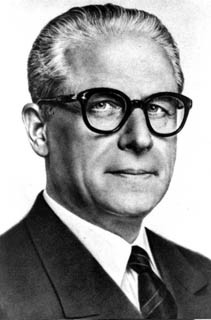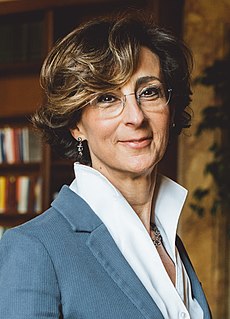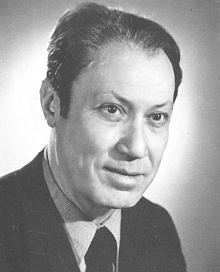
The politics of Italy are conducted through a parliamentary republic with a multi-party system. Italy has been a democratic republic since 2 June 1946, when the monarchy was abolished by popular referendum and a constituent assembly was elected to draft a constitution, which was promulgated on 1 January 1948.

The Italian Communist Party was a communist political party in Italy.

Carlo Levi was an Italian painter, writer, activist, communist, and doctor.

The history of the Italian Republic concerns the events relating to the history of Italy that have occurred since 1946, when Italy became a republic. The Italian republican history is generally divided into two phases, the so-called First and Second Republic.

The Italian Socialist Party was a socialist and later social-democratic political party in Italy, whose history stretched for longer than a century, making it one of the longest-living parties of the country.

Giovanni Gronchi, was an Italian politician from Christian Democracy who served as the president of Italy from 1955 to 1962 and was marked by a controversial and failed attempt to bring about an "opening to the left" in Italian politics. He was reputed the real holder of the executive power in Italy from 1955 to 1962, behind the various Prime Ministers of this time.

The Italian Liberal Party was a liberal and conservative political party in Italy.

This is a list of the Italian Ministers of Justice since 1946. The Minister of Justice is a senior member of the Italian Cabinet and leads the Ministry of Justice.
The Aventine Secession was the withdrawal of the parliament opposition, mainly comprising the Italian Socialist Party, Italian Liberal Party, Italian People's Party and Italian Communist Party, from the Italian Chamber of Deputies in 1924–25, following the murder of the deputy Giacomo Matteotti by fascists on June 10th, 1924.

The Italian General Confederation of Labour is a national trade union based in Italy. It was formed by agreement between socialists, communists, and Christian democrats in the "Pact of Rome" of June 1944. In 1950, socialists and Christian democrats split forming UIL and CISL, and since then the CGIL has been influenced by the Italian Communist Party (PCI) and until recent years by its political heirs: the Democratic Party of the Left (PDS), the Democrats of the Left (DS) and currently the Democratic Party (PD).

Concentrazione Antifascista Italiana, officially known as Concentrazione d'Azione Antifascista, was an Italian coalition of anti-fascist groups which existed from 1927 to 1934. It was formed in Paris on 27 March 1927 with the purpose of the organization of Italian antifascist forces in order to reorganize the anti-fascist movement abroad avoiding to repeat the old divisions existing in Italy before the establishment of the regime. The CAI made a public appeal signed by Claudio Treves and Giuseppe Emanuele Modigliani (PSLI), Pietro Nenni and Angelica Balabanoff (PSI), Fernando Schiavetti and Mario Pistocchi, Bruno Buozzi and Felice Quaglino (CGdL) and by Alceste De Ambris. Communists remained outside along with liberals, populars and others in order to keep contact with Italian masses «in their social defence and political resistance moves». The official weekly newspaper La Libertà was created on 1 May 1927 with Claudio Treves as director.

The Common Man's Front, also translated as Front of the Ordinary Man, was a short-lived right-wing populist, monarchist and anti-communist political party in Italy. It was formed shortly after the end of the Second World War and participated in the first post-war election for the constituent assembly in 1946. Its leader was the Roman writer Guglielmo Giannini, and its symbol was the banner of Giannini's newspaper L'Uomo qualunque.

The Italian Civil War was a civil war in the Kingdom of Italy fought during World War II from 8 September 1943 to 2 May 1945, by the Italian Fascists of the Italian Social Republic, a collaborationist puppet state created under the direction of Nazi Germany during its occupation of Italy, against the Italian partisans, materially supported by the Allies, in the context of the Italian campaign. The Italian partisans and the Italian Co-Belligerent Army of the Kingdom of Italy simultaneously fought against the occupying Nazi German armed forces. Armed clashes between the National Republican Army of the Italian Social Republic and the Italian Co-Belligerent Army of the Kingdom of Italy were rare, while there was some internal conflict within the partisan movement. In this context, Germans, sometimes helped by Italian Fascists, committed several atrocities against Italian civilians and troops.

The 1994 Italian general election was held on 27 and 28 March 1994 to elect members of the Chamber of Deputies and the Senate of the Republic for the 12th legislature. Silvio Berlusconi's centre-right coalition won a large majority in the Chamber of Deputies but just missed winning a majority in the Senate. The Italian People's Party, the renamed Christian Democracy (DC), which had dominated Italian politics for almost half a century, was decimated. It took only 29 seats versus 206 for the DC two years earlier—easily the worst defeat a sitting government in Italy has ever suffered, and one of the worst ever suffered by a Western European governing party.

Popular Unity was a short-lived social-democratic and social-liberal and political party in Italy. Its leaders were Piero Calamandrei, a Democratic Socialist, and Ferruccio Parri, a Republican and former Prime Minister.

Antonio Pennacchi was an Italian writer, winner of the Strega Prize in 2010 for his novel, Canale Mussolini.

The Italian Social Movement, renamed in 1972 Italian Social Movement – National Right, was a neo-fascist, nationalist and later national-conservative political party in Italy.

The Maximalist Italian Socialist Party or PSIm, was the residual part of the Italian Socialist Party in exile following the split that occurred during the first phases of the Socialist Convention of Grenoble, held on 16 March 1930, by Pietro Nenni and the fusionist fraction.

Paolo Vittorelli was the pseudonym used by Raffaello Battino, an Italian journalist-commentator, author and politician of the centre-left. As his public profile grew, he was increasingly referred to as Paolo Battino Vittorelli, the name by which he is identified in most posthumous sources. He engaged actively in antifascist propaganda work during the war years, most of which he spent exiled in Cairo.

















